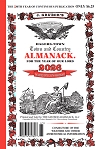John Gruber Exhibit Opens at the
Rural Heritage Museum Part 2
W
ith the items and vintage issues from the Gruber partners as a start, Marty continued to build a representative sampling of Gruber almanacs through its 220- year history as well as some other publications by Gruber. She identified several private collectors asking if they would be willing to support her efforts. From Carole Stoner, she received almanacs from 1893-1940 and from Richard Helfrich, almanac copies from years 1861, 1863-5, 1823, 1835, and 1840. Marty then turned to The Washington County Historical Society, Hagerstown Maryland, who maintains the most complete collection of Gruber’s almanacs (even more complete than the Gruber partner’s own collections and archives!). Anna Cueta, Curator of Collections agreed to not only loan select editions from their collection but also agreed to include their prized copy of Gruber’s The National Songster, America’s Most Admired Patriotic Songs printed by Gruber and his partner, Danial May in 1814. In it is Francis Scott Key’s famous poem "Defence of Fort McHenry” with directions that it is to be sung to the tune of ‘Anacreon of Heaven’, a popular English drinking song. It has been documented by the Library of Congress that this is the very first appearance of the poem as a song that would later be retitled The Star-Spangled Banner and become our national anthem. But the loan of these rare items required that the display conforms to strict AAM standards.
Starting with a retail display case recently donated to the museum, Marty and her team, Howard Meyers and Phil Muritz, set about to make the case AAM-compliant. The case dimensions measured 8 feet by 2 feet with 4 wooden shelves, each with an 8 inch tilt. All of the wooden surfaces of both the shelves and tilts were covered with TYVEK, a highly- effective moisture barrier used in housing construction and then wrapped entirely with unbleached muslin. This is done to prevent any gassing out from the wood which could seriously damage the artifacts displayed. The case was fitted with 2 sliding door locks and the top was re-glued for added security. The end result was a 32 linear feet of AAM-compliant display area. "The optimum upgrade would be to make the case air-tight and control the humidity from within it but that would be too cost-prohibitive”, said Marty and even though each of their 3 buildings are already temperature- and humidity-controlled, AAM standards still require that all individual display cases also adhere to the same strict climate control standards.
With the display case now up to AAM standards Marty needed to consider how to arrange the artifacts in an effective way. She determined that the artifacts be arranged in chronological order with all of the wood print blocks arranged on the top shelf of the exhibit case along with other artifacts starting with the oldest artifact , a book, "Evangelium Nicodemi” printed in Hagerstown by Gruber in 1796. The first 1797 issue is displayed alongside of the wood print block depicting its original German cover. The display continues with a copy of the rare 1800 issue with a memorial to George Washington who had died in 1799. The multiplication table copper plate is displayed next to the earliest table found which was in 1806, a wood cut of Gruber’s silhouette and his signature, as well as wood cut of his original print shop located on South Potomac Street in Hagerstown, Maryland. The National Songster, America’s Most Admired Patriotic Songs is prominently displayed, opened to the Francis Scott Key’s poem. Other significant editions are on display that include the 1823 issue which was the first issued in English with its corresponding issue in German, various almanacs in German after the start of English editions, a collection of the Civil War Era almanacs, and finally, the 1918 edition that was the last issue in German along with its corresponding English issue. It is noteworthy to point out that in no issues of English-language version is there any reference to war, politics or religious doctrine. The display concludes with a collection of books and pamphlets printed by Gruber that were sold in Hagerstown. The exhibit’s focal point is a beautiful 1777 map that chronicles Gruber’s life from his birth in Strasberg, Pennsylvania in 1768 to his death in Hagerstown, Maryland 1858.
It is an exhibit that shouldn’t be missed and even though it was intended for a limited run through September of 2016, plans are to make it a permanent addition to the museum’s outstanding exhibits. "We're an all-volunteer museum and although we try to be professional in every aspect, we are not there yet. BUT WE TRY SO HARD EVERYDAY!” said Marty with passion. The Almanack was extremely proud to be part of this effort to recognize John Gruber in this very special way and applauds her dedication as well as all of the other volunteers who work to make The Rural Heritage Museum of Washington County, Maryland what is today. Make plans to visit them soon!
For more HAGERSTOWN NEWS, click here


















